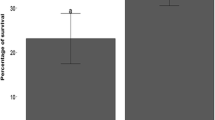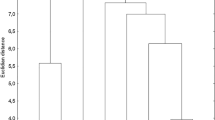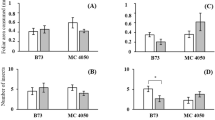Abstract
Three corn (Zea mays) germplasm lines [i.e., Ab24E (susceptible control), Mp708 (resistant control), and a locally selected partial inbred line FAW7050 (resistant)] were examined for Spodoptera frugiperda (J.E. Smith; Lepidoptera: Noctuidae) resistance. Nutritional [i.e., total protein content, amino acids, glucose, total nonstructural carbohydrates (TNC), protein to TNC (P/C) ratios] and biochemical (i.e., peroxidase and lipoxygenase 3) properties in the seedlings of these corn lines were examined to categorize resistance mechanisms to S. frugiperda. Physiological changes in photosynthetic rates also were examined in an attempt to explain nutritional and biochemical dynamics among corn germplasm lines and between insect-infested and noninfested corn plants within a germplasm line. Results indicated that S. frugiperda larvae survived better and developed faster in susceptible Ab24E than in resistant FAW7050 or Mp708. The three germplasm lines differed in resistance mechanisms to S. frugiperda, and the observed patterns of resistance were probably collective results of the P/C ratio and defensive proteins. That is, the susceptibility of Ab24E to S. frugiperda was due to a high P/C ratio and a low level of induced defensive compounds in response to insect herbivory, while the resistance of FAW7050 resulted from elevated defensive proteins following insect herbivory, low P/C ratio, and elevated defensive proteins in Mp708 contributed to its resistance to S. frugiperda. The elevated protein amounts in resistant Mp708 and FAW7050 following S. frugiperda injury were likely due to greater conversion of photosynthates to defensive proteins following the greater photosynthetic rates in these entries. Greater photosynthetic capacity in Mp708 and FAW7050 also led to higher amino acid and glucose contents in these two lines. Neither amino acid nor lipoxygenase 3 played a critical role in corn resistance to S. frugiperda. However, high inducibility of peroxidase may be an indicator of S. frugiperda susceptibility as observed elsewhere.



Similar content being viewed by others
References
Axelrod, B., Cheesbrough, T. M., and Laakso, S. 1981. Lipoxygenase from soybeans. Method Enzymol. 71:441–451.
Bede, J. C., Mcneil, J. N., and Tobe, S. S. 2007. The role of neuropeptides in caterpillar nutritional ecology. Peptides 28:185–196.
Bi, J. L., Murphy, J. B., and Felton, G. W. 1997. Antinutritive and oxidative components as mechanisms of induced resistance in cotton to Helicoverpa zea. J. Chem. Ecol. 23:97–117.
Bi, J. L., Ballmer, G. R., Hendrix, D. L., Henneberry, T. J., and Toscano, N. C. 2001. Effects of cotton nitrogen fertilization on Bemisia argentifolii populations and honeydew production. Entomol. Exp. Appl. 99:25–36.
Bi, J. L., Toscano, N. C., and Madore, M. A. 2003. Effect of urea fertilizer application on soluble protein and free amino acid content of cotton petioles in relation to silverleaf whitefly (Bemisia argentifolii) populations. J. Chem. Ecol. 29:747–761.
Broadway, R. M., and Duffey, S. S. 1988. The effects of plant protein quality on insect digestive physiology and the toxicity of plant proteinase inhibitors. J. Insect Physiol. 34:1111–1117.
Burton, R. L. 1969. Mass Rearing the Corn Earworm in the Laboratory. USDA-ARS No. 33-134, USA, pp 1–8.
Callahan, F. E., Davis, F. M., and Williams, W. P. 1992. Steady-state polypeptide profiles of whorl tissue from Lepidoptera-resistant and susceptible corn inbred lines. Crop Sci. 32:1203–1207.
Chen, Y., Ruberson, J. R., and Olson, D. M. 2008. Nitrogen fertilization rate affects feeding, larval performance, and oviposition preference of the beet armyworm, Spodoptera exigua, on cotton. Entomol. Exp. Appl. 126:244–255.
Chittoor, J. M., Leach, J. E., and White, F. F. 1999. Induction of peroxidase during defense against pathogens, pp. 171–193, in S. K. Datta, and S. Muthukrishnan (eds.). Pathogenesis-related proteins in plantsCRC, Boca Raton, FL.
Curran, P. J., Dungan, J. L., and Gholz, H. L. 1990. Exploring the relationship between reflectance red edge and chlorophyll content in slash pine. Tree Physiol. 7:33–48.
Davis, F. M., Ng, S. S., and Williams, W. P. 1992. Visual rating scales for screening whorl-stage corn for resistance to fall armyworm. Technical Bulletin 186, Mississippi Agricultural and Forestry Experiment Station, 9 pp.
Davis, F. M., Wiseman, B. R., Williams, W. P., and Widstrom, N. W. 1996. Insect colony, planting date, and plant growth stage effects on screening maize for leaf-feeding resistance to fall armyworm (Lepidoptera: Noctuidae). Fla. Entomol. 79:317–328.
Doi, E., Shibata, D., and Matoba, T. 1981. Modified colorimetric ninhydrin methods for peptidase assay. Anal. Biochem. 118:173–184.
Duffey, S. S., and Stout, M. J. 1996. Antinutritive and toxic compounds of plant defense against insects. Arch. Insect Biochem. Physiol. 32:3–37.
Felton, G. W., Summers, C. B., and Mueller, A. J. 1994. Oxidative responses in soybean foliage to herbivory by bean leaf beetle and three-cornered alfalfa leafhopper. J. Chem. Ecol. 20:639–650.
Filella, I., Serrano, L., Serra, J., and PEÑUELAS, J. 1995. Evaluating wheat nitrogen status with canopy reflectance indices and discriminant analysis. Crop Sci. 35:1400–1405.
Fisher, G. H., Arias, I., Quesada, I., D’aniello, S., Errico, F., Di fiore, M. M., and D’aniello, A. 2001. A fast and sensitive method for measuring picomole levels of total free amino acids in very small amounts of biological tissues. Amino Acids 20:163–173.
Fox, L. R., Letourneau, D. K., Eisenbach, J., and Nouhuys, S. V. 1990. Parasitism rates and sex ratios of a parasitoid wasp: effects of herbivore and plant quality. Oecologia 83:414–419.
Heng-moss, T., Sarath, G., Baxendale, F., Novak, D., Bose, S., Ni, X., and Quisenberry, S. 2004. Characterization of oxidative enzyme changes in buffalo grasses challenged by Blissus occiduus. J. Econ. Entomol. 97:1086–1095.
Hildebrand, D. F., Rodriguez, J. G., Legg, C. S., Brown, G. C., and Bookjans, G. 1989. The effects of wounding and mite infestation on soybean leaf lipoxygenase levels. Z. Naturforsch C 44:655–659.
Jones, M. G. K. 1979. An enzymic microassay for starch. Plant, Cell and Environ. 2:227–234.
Jongsma, M. A., Bakker, P. L., Visser, B., and Stiekema, W. J. 1994. Trypsin inhibitor activity in mature tobacco and tomato plants is mainly induced locally in response to insect attack, wounding and virus infection. Planta 195:29–35.
Lawrence, P. K., and Koundal, K. R. 2002. Plant protease inhibitors in control of phytophagous insects. EJB Electron. J. Biotechn. 5:93–109.
Lee, K. P., Behmer, S. T., Sempson, S. J., and Raubenheimer, D. A. 2002. A geometric analysis of nutrient regulation in the generalist caterpillar Spodoptera littoralis (Boisduval). J. Insect Physiol. 48:655–665.
Leo, F. D., Bonadé-bottino, M., Ceci, L. R., Gallerani, R., and Jouanin, L. 2001. Effects of a mustard trypsin inhibitor expressed in different plants on three lepidopteran pests. Insect Biochem. Molec. Biol. 31:593–602.
Markwell, J., Osterman, J. C., and Mitchell, J. L. 1995. Calibration of the Minolta SPAD-502 leaf chlorophyll meter. Photosynth. Res. 46:467–472.
Marquis, R. J., Newell, E. A., and Villegas, A. C. 1997. Non-structural carbohydrate accumulation and used in an understory rain-forest shrub and relevance for the impact of leaf herbivory. Funct. Ecol. 11:636–643.
Mattson, W. J. Jr. 1980. Herbivory in relation to plant nitrogen content. Annu. Rev. Ecol. Systematics 11:119–161.
Ni, X., and Quisenberry, S. S. 2003. Possible roles of esterase, glutathione S-transferase, and superoxide dismutase activity in understanding aphid–cereal interactions. Entomol. Exp. Appl. 108:187–195.
Ni, X., Quisenberry, S., Heng-Moss, T., Markwell, J., Sarath, G., Klucas, R., and Baxendale, F. 2001. Oxidative responses of resistant and susceptible cereal leaves to symptomatic and nonsymptomatic cereal aphid (Hemiptera: Aphididae) feeding. J. Econ. Entomol. 94:743–751.
Ni, X., Krakowsky, M. D., Burtin, G. D., Rector, B. G., Guo, B., and Snook, M. E. 2008. Identification of multiple ear-colonizing insect and disease resistance in CIMMYT maize inbred lines with varying levels of silk maysin. J. Econ. Entomol. 101:1455–1465.
Paul, J. K. 1981. Carbon dioxide concentration, photosynthesis, and dry matter production. BioScience 31:29–33.
Paul, M. J., and Foyer, C. H. 2001. Sink regulation of photosynthesis. J. Exp. Botany 52:1383–1400.
Prudic, K. L., Oliver, J. C., and Bowers, M. D. 2005. Soil nutrient effects on oviposition preference, larval performance and chemical defense of a specialist insect herbivore. Oecologia 143:578–587.
Richardson, A. D., Duigan, S. P., and Berlyn, G. P. 2002. An evaluation of noninvasive methods to estimate foliar chlorophyll content. New Phytol. 153:185–194.
Ryan, C. A. 1990. Protease inhibitors in plants: genes for improving defenses against insects and pathogens. Annu. Rev. Phytopathol. 28:425–449.
SAS INSTITUTE. 1999. SAS/STAT user’s guide. 8th edn. SAS Institute, Cary, NC.
Shukle, R. H., and Murdock, L. L. 1983. Lipoxygenase, trypsin inhibitor, and lectin from soybeans: effects on larval growth of Manduca sexta (Lepidoptera: Sphingidae). Environ. Entomol. 12:789–791.
Simpson, S. J., and Raubenheimer, D. 1993. The central role of the haemolymph in the regulation of nutrient intake in insects. Physiol. Entomol. 18:395–403.
Smith, C. M., Khan, Z. R., and Pathak, M. D. 1994. Evaluation of plants for insect resistance, pp. 17–114, in C. M. Smith, Z. R. Khan, and M. D. Pathak (eds.). Techniques for Evaluating Insect Resistance in Crop PlantsCRC, Boca Raton, FL.
Stout, M. J., Workman, J., and Duffey, S. S. 1994. Differential induction of tomato foliar proteins by arthropod herbivores. J. Chem. Ecol. 20:2575–2594.
Stout, M. J., Workman, K. V., Bostock, R. M., and Duffey, S. S. 1998. Specificity of induced resistance in the tomato, Lycopersicon esculentum. Oecologia 113:74–81.
Ussuf, K. K., Laxmi, N. H., and Mitra, R. 2001. Proteinase inhibitors: plant-derived genes of insecticidal protein for developing insect-resistant transgenic plants. Curr. Sci. 80:847–853.
White, T. C. R. 1984. The abundance of invertebrate herbivores in relation to the availability of nitrogen in stressed food plants. Oecologia 63:90–105.
White, T. C. R. 1993. The Inadequate Environment: Nitrogen and Abundance of Animals. Springer, Berlin425 p.
Widstrom, N. W., Williams, W. P., Wiseman, B. R., and Davis, F. M. 1993. Registration of GT FAWCC(C5) maize germplasm. Crop Sci. 33:1422.
Williams, W. P., Davis, F. M., and Windham, G. L. 1990. Registration of Mp708 germplasm line of maize. Crop Sci. 30:757.
Woods, H. A. 1999. Patterns and mechanisms of growth of fifth-instar Manduca sexta caterpillars following exposure to low- or high-protein food during early instars. Physiol. Biochem. Zool. 72:445–454.
Zavala, J. A., Patanker, A. G., Gase, K., Hui, D., and Baldwin, I. T. 2004. Manipulation of endogenous trypsin proteinase inhibitor production in Nicotiana attenuate demonstrates their function as antiherbivore defenses. Plant Physiol. 134:1181–1190.
Acknowledgments
Mention of trade names or commercial products in this article is solely for the purpose of providing specific information and does not imply recommendation or endorsement by the US Department of Agriculture. The authors are indebted to Drs. Dawn Olson and Baozhu Guo (USDA-ARS Crop Protection and Management Research Unit, Tifton, GA, USA) and two anonymous reviewers for their reviews of the early drafts of this manuscript. The study was supported in part by the Georgia Corn Commission Research Fund.
Author information
Authors and Affiliations
Corresponding author
Rights and permissions
About this article
Cite this article
Chen, Y., Ni, X. & Buntin, G.D. Physiological, Nutritional, and Biochemical Bases of Corn Resistance to Foliage-Feeding Fall Armyworm. J Chem Ecol 35, 297–306 (2009). https://doi.org/10.1007/s10886-009-9600-1
Received:
Revised:
Accepted:
Published:
Issue Date:
DOI: https://doi.org/10.1007/s10886-009-9600-1




